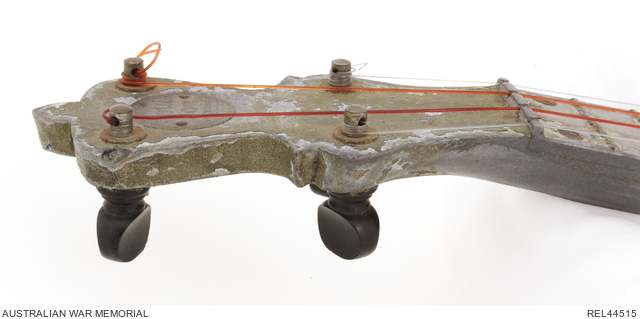| Places | |
|---|---|
| Accession Number | REL44515 |
| Collection type | Heraldry |
| Object type | Heraldry |
| Physical description | Aluminium, Animal hide, Bakelite, Brass, Nickel-plated brass, Tin |
| Maker |
Unknown |
| Place made | United Kingdom: England |
| Date made | c 1930 |
| Conflict |
Second World War, 1939-1945 |
| Source credit to | This item has been digitised with funding provided by Commonwealth Government. |
'Jolli-Joe' banjo-ukulele : Lance Corporal S V Finnigan, 55/53 Battalion CMF





Aluminium necked, pressed steel bodied banjo-ukulele with tin resonator, nickle-plated brass endpiece, nickle-plated brass j-hooks, wooden bridge and bakelite machine heads. A circular brass plate, impressed in decorative script 'Jolli-Joe / The U.K. Uke / Prov Act Reg'd Design', is set into a circular recess at the top of the headstock. The fretboard is a separate moulding which is double-screwed to the neck at the first, eighth and sixteenth frets; the fretboard dots are dished recesses which still retain traces of red paint. The body and neck have been finish in a green crackle finish, much of which has been worn away from the neck through playing. It appears that the resonator may have also had this finish, but it has been overpainted in black. There appears to be a pair of green felt damping pads held in tension between the resonator and the rear frame.
The skin has been signed by members of 55/53 Battalion or their associates. Legible names written on the skin include: 'Swing' Finnigan NG; Jack Richardson; R. West; Scott Keith; Bluey Barkas; Franky Le Poidevin; Charlie Bailey; Chesty Bond; Capt R. Young; Jim Cott; R. Black; D. Wallace; W. Wark; 'Stick' Hennesey; 'Killer' Kelly; 'Pike' Reynolds. The strings are recent replacements.
Ukulele-banjo, sometimes known as a banjolele, acquired by Stenley Vincent 'Vince' Finnigan. Finnigan was born on 15 January 1922 at Grafton, NSW. A self-taught musician, he enlisted with 55/53 Battalion in 1941.
He served in New Guinea on the Kokoda Trail and in the Buna Campaign, before returning to Australia in early March 1943 on the transport ship Duntroon, reaching Cairns, Qld three days later. The 55th/53rd then travelled to Ravenshoe, approximately 220 km south of Cairns, where the men were given leave. Occasionally they would hold exercises at Trinity Beach and use the camp at Whiterock